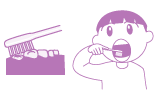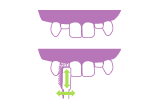Care by age group: School-Age

Adolescent children are at an important stage in which their milk teeth are replaced by
permanent teeth. Establish the habit of brushing, so as to achieve healthy teeth and a
healthy mouth.
permanent teeth. Establish the habit of brushing, so as to achieve healthy teeth and a
healthy mouth.
POINTS TO NOTE
- During the period of transition from milk teeth to permanent teeth, teeth become misaligned. Therefore, attention should be paid as to how the toothbrush is used on teeth.
Dental and Oral Health and Care for Adolescent Children
Adolescent Children
Features of Teeth
- Stage of transition from milk teeth to permanent teeth
Adolescent children are at a stage of transition from milk teeth to permanent teeth. Permanent teeth start replacing milk teeth at about age 6, and all 28 permanent teeth will be in place by about age 12.During this stage, teeth are often out of alignment due to the loss and emergence of teeth, and for this reason, this is the most difficult stage in life for brushing teeth.
- Period of frequent occurrence of caries in permanent teeth
A newly-emerged permanent tooth is the most susceptible to caries, because the tooth itself is still immature and vulnerable to acid. In order to prevent caries, it is recommended that children at this stage receive regular checkups, tooth brushing instruction and preventive measures (fluorine coatings, etc.) at a dentist office. In addition, early caries can be treated by the use of fluoride toothpaste.
Reminders
In this stage where the transition from milk teeth to permanent teeth takes place, teeth become misaligned, resulting in complex teeth alignment; for this reason, some technique is required when brushing, including how the toothbrush is used. In addition, final polishing (checkup brushing) by the parent is necessary until the child reaches 8 or 9 years of age.

1. Occlusion between molars
Place the toothbrush vertical to the chewing surface, and move
the brush back and forth in small motions. Place the toothbrush
perpendicular against the teeth, and brush in small motions.
the brush back and forth in small motions. Place the toothbrush
perpendicular against the teeth, and brush in small motions.

2. Newly-erupted teeth (first molars, etc.)
A newly-erupted tooth is short in height and hard to reach with
a toothbrush. To make brushing such a tooth easier, insert the
toothbrush at an angle from the side, as in the picture. Insert
the toothbrush at an angle from the side.
a toothbrush. To make brushing such a tooth easier, insert the
toothbrush at an angle from the side, as in the picture. Insert
the toothbrush at an angle from the side.

3. Areas where teeth are misaligned
Hold the toothbrush vertically and place it on each misaligned
tooth, and move the tips of the bristles up and down in small
motions. Place the toothbrush vertically against each tooth, and
move the tips of the bristles up and down in small motions.
tooth, and move the tips of the bristles up and down in small
motions. Place the toothbrush vertically against each tooth, and
move the tips of the bristles up and down in small motions.
4. Grooves on the back side of the upper front teeth
Holding the toothbrush vertically, place the tips of the bristles
perpendicular against the back surface of the teeth and brush
in small motions.
perpendicular against the back surface of the teeth and brush
in small motions.





